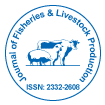Genetic Innovations in Livestock and Aquaculture: Enhancing Productivity and Disease Resistance
Received Date: Feb 01, 2025 / Published Date: Feb 26, 2025
Abstract
Genetic innovations in livestock and aquaculture are transforming food production by enhancing productivity, disease resistance, and environmental sustainability. Advances in genome editing, selective breeding, and molecular genetics have enabled the development of animals with improved growth rates, feed efficiency, and resilience to diseases. In livestock, CRISPR-Cas9 technology, marker-assisted selection (MAS), and transgenic modifications have led to breeds with enhanced meat, milk, and reproductive traits while reducing susceptibility to infectious diseases. Similarly, genetic improvements in aquaculture species, such as Atlantic salmon, tilapia, and shrimp, have optimized growth performance and resistance to viral and bacterial infections. These innovations contribute to reducing antibiotic use, lowering production costs, and improving food security. However, ethical considerations, regulatory challenges, and public acceptance remain key factors influencing their adoption. This paper explores the latest advancements in genetic technologies for livestock and aquaculture, their implications for global food systems, and the challenges associated with their implementation.
Citation: Ames M (2025) Genetic Innovations in Livestock and Aquaculture: Enhancing Productivity and Disease Resistance. J Fisheries Livest Prod 13: 623. Doi: 10.4172/2332-2608.1000623
Copyright: © 2025 Ames M. This is an open-access article distributed under the terms of the Creative Commons Attribution License, which permits unrestricted use, distribution, and reproduction in any medium, provided the original author and source are credited.
Share This Article
Recommended Journals
Open Access Journals
Article Tools
Article Usage
- Total views: 113
- [From(publication date): 0-0 - Apr 19, 2025]
- Breakdown by view type
- HTML page views: 79
- PDF downloads: 34
